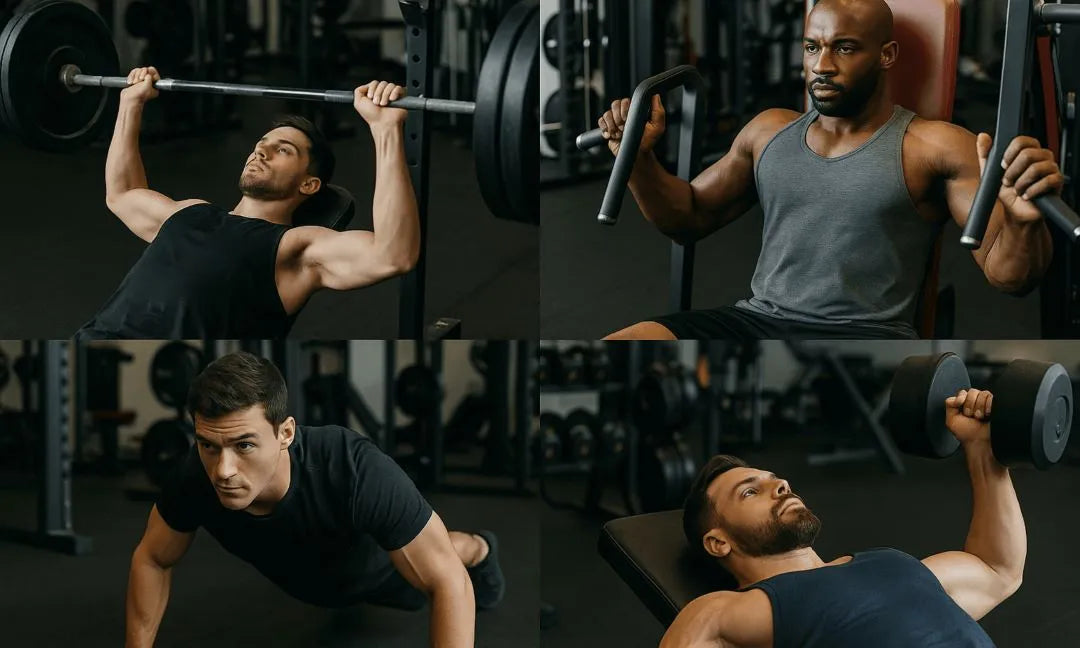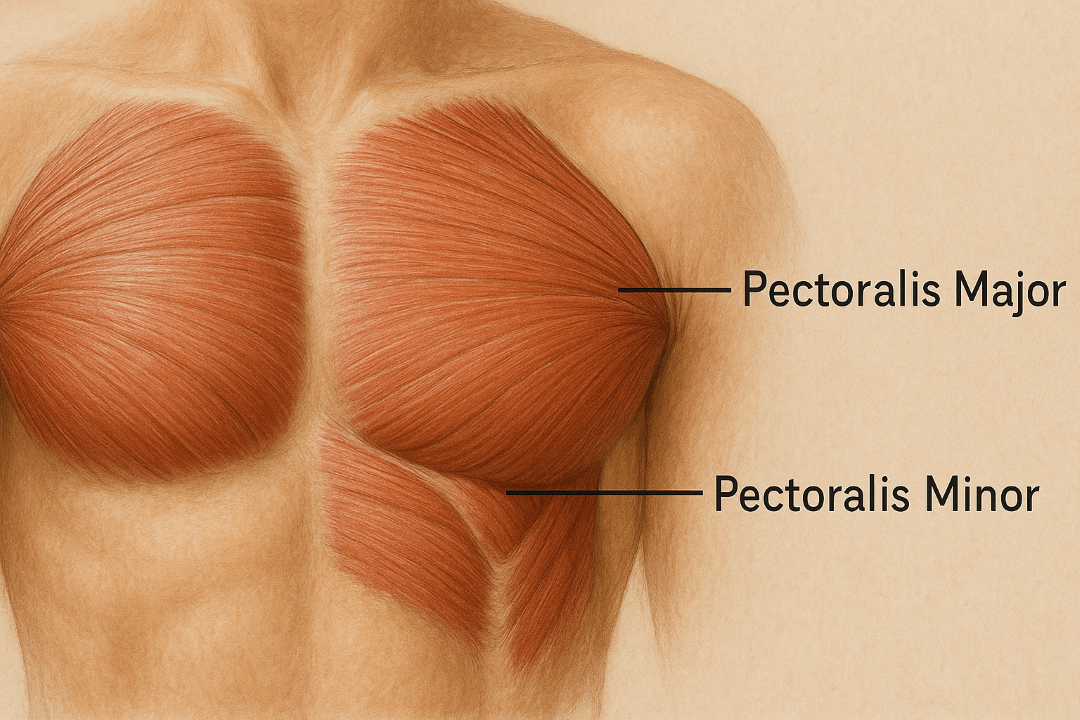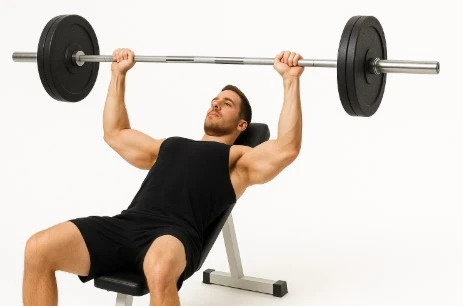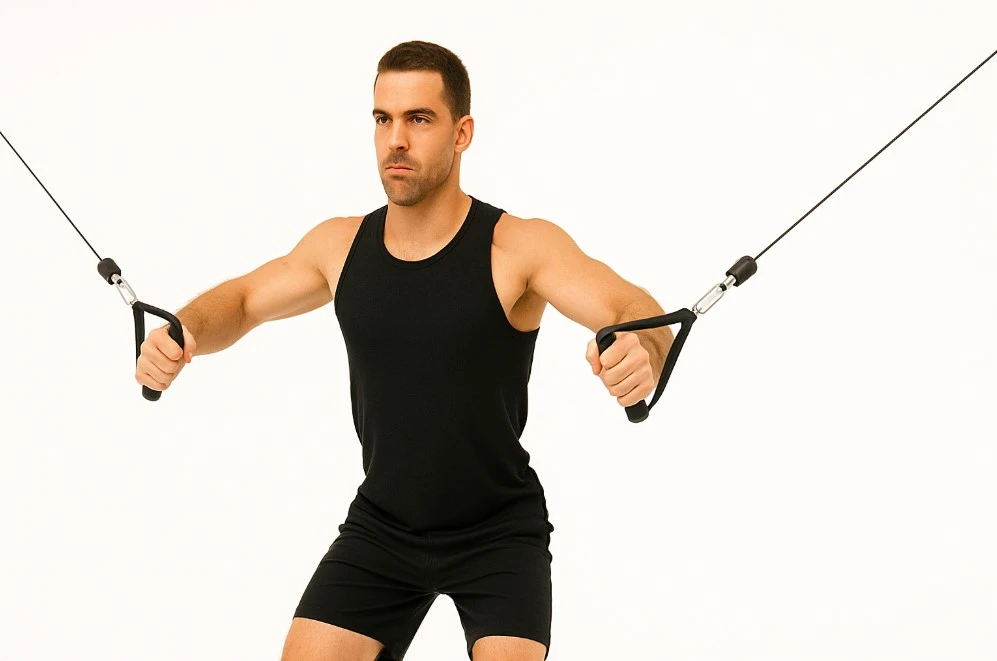
Top Chest Workouts to Build Strength and Definition for Every Level
Share
Introduction to Chest Muscles
The chest is made up of two main muscles: the pectoralis major and the pectoralis minor. These are key players in upper body movement and strength.

Knowing how the chest muscles work is important if you want to get the most out of your training. The best chest workouts target all areas, upper, lower, and mid-chest to create balanced development. Effective chest exercises also recruit more muscle fibres, maximising growth and ensuring balanced muscle development.
A well-built chest isn't just about looks, it's a sign of strength and athleticism. Chest training also contributes to improved posture by supporting better body alignment and spinal positioning. Whether you're just starting out or have been training for years, developing your chest should be a priority.
Table of Contents
- Introduction to Chest Muscles
- Why Chest Exercises Matter
- Best Chest Exercises for Beginners
- Intermediate Chest Workout
- Advanced Chest Workout
- How to Build a Bigger Chest
- Warming Up and Chest Activation
- Nutrition for Chest Growth
- Sample Chest Day Routine
- Best Chest Exercises to Include
- Chest Press Variations
- Bench Press Tips
- Benefits of the Barbell Bench Press
- Cable Chest Press
- Home Chest Workout
- Gym Chest Workout
- Chest Training for Women
- Chest Workout for Men
- Creating a Chest Workout Plan
- Tips for an Effective Chest Workout
- Common Mistakes to Avoid
- FAQ
Why Chest Exercises Matter
Training your chest isn't just about benching big numbers, it plays a big role in overall upper body strength. A strong chest helps with posture and makes everyday tasks like pushing, lifting, or carrying much easier. Chest exercises can also benefit the entire body by engaging multiple muscle groups simultaneously, supporting overall fitness and strength.
Because most chest movements involve pushing, they also activate other muscles like the shoulders and triceps. Exercises like the bench press and push-ups are especially effective, as they work multiple muscle groups at once.
Adding chest exercises to your routine will not only build muscle but also improve your general fitness and reduce the risk of injury. Chest workouts contribute to functional fitness, making daily activities easier and more efficient.
Best Chest Exercises for Beginners
If you're new to training, start with the basics:
-
Standard Bench Press: Lie on the bench with your knees bent and feet flat on the floor. Grip the barbell just wider than shoulder-width. Before you begin, ensure you are in the correct starting position. Start with a lighter weight to master your form. Slowly lower the bar to your chest in a controlled manner, then press it back up. Stick to a full range of motion and avoid half reps.

-
Push-Ups: One of the simplest but most effective exercises using just your bodyweight. Begin in the starting position with your hands shoulder width apart and your body in a straight line. Slowly lower yourself, then push back up until your arms are extended.

-
Dumbbell Presses (Flat or Incline): A great way to work the upper chest while improving stability. Lie back with your knees bent and feet on the floor. Start with a lighter dumbbell to get your form right. As you press, keep your upper arms under control and reach shoulder height at the top of each rep, focusing on squeezing your chest.
-
Cable Flyes: Cable Flyes isolate the chest muscles and help build definition. Set up with your palms facing each other and maintain a slight bend in your arms. Control the movement through the full range—don't rush.

Intermediate Chest Workout
Once you've nailed the basics, it's time to step things up. Intermediate workouts introduce more variety and intensity to keep your progress going.
Start with flat pressing to target the mid and lower chest. Make sure to avoid partial reps, completing full repetitions is crucial for full muscle engagement and optimal growth. Follow it up with incline presses to shift the focus to the upper chest. Both dumbbell and cable flyes are brilliant for stretching the muscle and encouraging growth.
Dumbbell presses use the same movement as barbell presses but allow for a greater range of motion. This increased range of motion helps recruit more muscle fibres, leading to better hypertrophy and muscle development.
To get more out of your training, experiment with grip width and bench angles. A wider grip on the bar activates more chest, while small changes in bench incline can shift the focus to different areas. Mixing compound movements with isolation exercises ensures your entire chest gets worked properly.
Advanced Chest Workout
Advanced lifters should look to challenge themselves with variations and combinations of exercises.
-
Barbell Variations: Incorporate incline, decline, and flat bench presses. A close-grip bench press also hits the triceps while giving the chest a serious workout. Always finish each rep with your arms fully extended to ensure complete muscle engagement and safety.
-
Control is Key: Lower the bar slowly, brace your core, and keep your shoulder blades pulled back for stability and maximum muscle activation. Focus on engaging your stabilising muscles to maintain proper form during advanced lifts.
-
Dumbbell and Cable Work: Use these for extra range of motion and to isolate different parts of the chest. Try to pause briefly in the stretched position during cable flyes for more activation.
-
Explosive Movements: Medicine ball throws, clapping push-ups, or ring push-ups are bodyweight movements that will build power and improve coordination. During these exercises, keep your core locked and maintain a plank position for stability. For ring push-ups and clapping push-ups, focus on keeping straight arms and arms fully extended at the top of each rep.
How to Build a Bigger Chest
If your goal is size, focus on these essentials:
-
Regular chest work is key for chest gains. Train your chest consistently using compound lifts like bench presses and push-ups.
-
Use progressive overload, gradually increase the weight or reps.
-
Target every part of the chest by mixing flat, incline, and decline presses.
-
Nutrition matters: eat enough protein, carbs, and healthy fats to support growth and recovery. A post workout protein shake is especially important for replenishing glycogen and supporting muscle repair after your session.

Warming Up and Chest Activation
Warming up properly helps prevent injury and improves performance.
-
Start with dynamic movements like arm circles or light resistance band presses, making sure to establish a proper start position for each exercise to ensure correct form and alignment.
-
Include chest stretches to activate smaller muscles like the pec minor, focusing on movements that help move the shoulder forward and engage the chest.
-
Foam rolling the chest and shoulders can reduce tension and improve mobility.
A solid warm-up will help you lift more effectively and stay injury-free.
Nutrition for Chest Growth
Muscle growth doesn't happen without the right fuel:
-
Aim for 1.6–2.2g of protein per kilo of bodyweight daily.
-
Don't skimp on carbs, they're your energy source.
-
Healthy fats help with hormone production and recovery.
-
After training, eat a mix of protein and carbs to aid muscle repair.
Base your diet around whole foods: lean meat, eggs, dairy, fish, and whole grains are all great choices.
Sample Chest Day Routine
A good chest day includes a mix of heavy lifts and isolation work:
-
Warm-up: Dynamic stretches, light pressing
-
Flat Barbell Bench Press – 4 sets
-
Incline Dumbbell Press – 3 sets
-
Cable Flyes – 3 sets
-
Push-Ups (to failure) – 2 sets
-
Cool down with stretches and light band work
Including all the exercises in your routine ensures balanced chest development and helps you achieve progressive overload.
Remember to increase weight over time and support your training with good nutrition and rest.
Best Chest Exercises to Include
The most effective chest exercises are:
-
Compound lifts and pressing movements: Bench presses, push-ups (these pressing movements target different areas of the chest and are key for overall size and definition)
-
Isolation exercises: Cable flyes, dumbbell flyes
-
These moves hit all parts of the chest and help build both strength and definition.
A balanced chest makes your whole upper body look and perform better.
Chest Press Variations
Adding variety to your chest press routine is key to building a well-rounded, muscular chest. The best chest exercises, like the bench press, can be tweaked to hit different areas of the chest muscles for balanced development. For example, the incline bench press shifts the focus to the upper chest, helping you build that sought-after upper body thickness. The flat bench press is a classic move that targets the middle of the chest, while the decline bench press emphasizes the lower chest for complete muscle growth.
Changing your grip can also make a big difference. A close grip bench press brings the triceps and inner chest into play, while a wider grip puts more stress on the outer chest. Swapping the barbell for dumbbells, like in the dumbbell bench press, lets you move through a greater range of motion, activating more muscle fibers and improving stability. Using an incline bench or flat bench with dumbbells can help you find the best chest activation for your body.
Mixing up your chest press variations not only keeps your chest workout interesting but also ensures you're targeting every part of the chest muscles for the best results.
Bench Press Tips
Good form is crucial for safety and results:
-
Keep your feet flat and your back firmly on the bench.
-
Use a shoulder-width apart grip on the bar.
-
Grip the bar with your palms facing forward. Lower it under control to your chest, then press up until your arms are fully extended.
-
Focus on squeezing your chest at the top of each rep.
Benefits of the Barbell Bench Press
The barbell bench press is a staple for a reason:
-
Works the chest, shoulders, and triceps
-
Builds strength and size
-
Allows for heavier loads and progression
-
Can be adapted to suit your fitness level
For added safety and support, especially when your stabilising muscles are fatigued, you can use a smith machine for the bench press.
It's one of the best bang-for-your-buck exercises.
Cable Chest Press
The cable chest press is ideal for targeting specific areas of the chest.
-
It helps improve definition and isolation. Using a neutral grip during the cable chest press can maximise muscle engagement and comfort, while reducing strain on the shoulders.
-
You can adjust the setup to focus on upper or lower chest.
-
Use a steady tempo and full range of motion for best results.
It's also joint-friendly and great for adding volume without too much strain.
Home Chest Workout
You don't need fancy equipment for an effective home chest session:
-
Push-Ups: Standard, decline, wide-grip, and close-grip for variety. Keep your body straight throughout the movement to ensure proper form and maximize core engagement.
-
Resistance Bands: Band presses and flyes add extra resistance
-
Dumbbells: If available, use for flat or incline presses
With a bit of creativity, you can still build serious strength and definition at home.
Gym Chest Workout
Training in the gym gives you access to more tools:
-
Flat, incline, and decline benches help target the chest from all angles.
-
Dumbbells and barbells build raw strength.
-
Machines and cables provide controlled resistance and better isolation.
Use the full range of equipment to create a balanced, effective routine.
Chest Training for Women
-
Builds strength and supports posture
-
Improves muscle tone across the shoulders and arms
-
Boosts overall upper body performance
Start with bodyweight moves like push-ups, then progress to dumbbell presses and flyes. Focus on form and consistency for the best results. Remember to keep your chest lifted during each exercise to enhance posture and maximize muscle activation.
Chest Workout for Men
A solid chest workout for men should combine heavy compound lifts with focused isolation moves to maximise muscle growth and upper body strength.
Start your session with the bench press, a proven exercise for building the chest muscles and boosting overall upper body power. Aim for 3-4 sets of 8-12 reps, using a weight that challenges you while maintaining good form.
Follow up with dumbbell flyes to stretch and isolate the chest, targeting both the upper chest and lower chest for balanced development. Perform 3-4 sets of 12-15 reps, focusing on a controlled motion and a strong squeeze at the top.
Don't forget to include exercises that work the surrounding muscles, like the shoulders and triceps, to support your upper body strength and prevent imbalances.
Using free weights, such as dumbbells, encourages more muscle activation and helps you build a bigger, stronger chest. By targeting all areas of the chest and supporting muscles, you'll see better muscle growth and a more defined upper body.
Creating a Chest Workout Plan
Designing an effective chest workout plan starts with choosing the best chest exercises to target every part of the chest muscles. Begin each session with a compound movement like the bench press to build strength and hit the major muscle groups. Next, add pushing movements such as the chest press and push ups to further challenge your upper body and promote muscle growth.
Incorporate isolation exercises like chest flyes—using dumbbells or cables—to stretch the chest and improve definition. Don't overlook the importance of a proper warm-up: start with bodyweight push ups or resistance band exercises to activate the chest and prepare your muscles for heavier lifts.
A balanced chest workout plan should include a mix of pressing and stretching movements, target the upper body from different angles, and allow for progressive overload. This approach will help you build the best chest possible, improve posture, and increase overall upper body strength.
Tips for an Effective Chest Workout
-
Warm up properly to reduce injury risk
-
Prioritise good form over heavy weights
-
Gradually increase the weight or reps
-
Stay consistent and fuel your body with proper nutrition
-
Listen to your body—don't push through pain
Common Mistakes to Avoid
-
Poor form, especially not using a full range of motion
-
Skipping warm-ups or cool-downs
-
Not eating enough to support growth
-
Neglecting progressive overload
-
Overtraining or not allowing enough recovery
FAQ
1. How often should I train my chest each week?
For most people, training the chest 1–2 times per week is ideal. Beginners can start with once a week, while intermediate and advanced lifters often see the best results training chest twice weekly, allowing at least 48 hours between sessions for recovery.
2. What's the best chest exercise for beginners?
Push-ups and the flat bench press are great starting points. Push-ups help build bodyweight strength and form, while bench presses introduce the foundational pressing movement that targets multiple upper body muscles.
3. Should I use barbells or dumbbells for chest workouts?
Both are effective.
-
Barbells allow you to lift heavier and are great for building strength.
-
Dumbbells offer more range of motion and help improve muscle balance and stability.
Use both to get the best results.
4. How can I target my upper chest more?
Use incline bench presses, incline dumbbell presses, and low-to-high cable flyes. Adjusting your bench to a 30–45° incline is ideal for upper chest activation.
5. What if I don't have access to a gym?
No problem. You can build chest strength at home with:
-
Push-up variations (standard, incline, decline, wide-grip)
-
Resistance bands for presses and flyes
-
Dumbbells, if available, for home bench or floor presses
6. Why isn't my chest growing even though I train regularly?
It could be due to:
-
Lack of progressive overload (not increasing weights or reps)
-
Poor form or incomplete range of motion
-
Not training all areas (upper, middle, lower chest)
-
Inadequate nutrition or rest
Review your plan and make sure you're focusing on intensity, form, and recovery.
7. How important is diet for chest development?
Extremely important. Your muscles won't grow without the right fuel. Aim for:
-
1.6–2.2g of protein per kg of bodyweight
-
Plenty of carbs and healthy fats
-
A post-workout meal with protein and carbs for recovery
8. Do women need to train their chest muscles too?
Yes! Chest training improves posture, upper body strength, and muscle tone across the shoulders, arms, and chest. It's just as beneficial for women as it is for men.
9. Can I train chest and triceps on the same day?
Yes. Many chest exercises (like bench presses and push-ups) already engage the triceps. Pairing them together makes sense and can create a highly efficient upper body workout.
10. How do I avoid shoulder pain during chest workouts?
-
Always warm up properly
-
Keep your shoulder blades retracted during pressing
-
Use a natural grip width (not too wide)
-
Avoid overloading too early—prioritise form over heavy weights
If pain persists, consult a physiotherapist.
